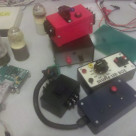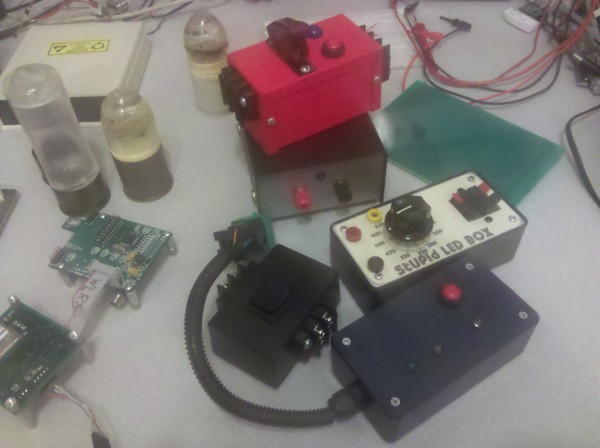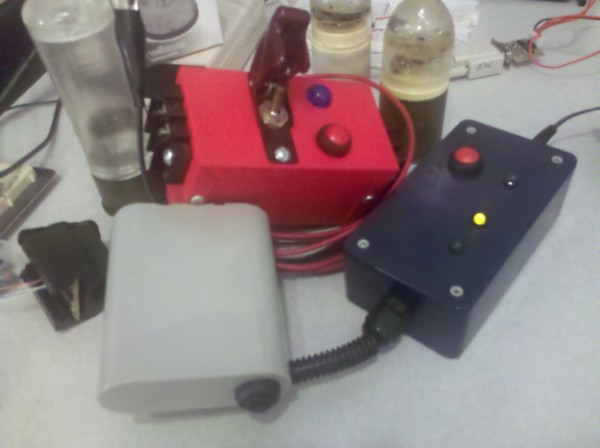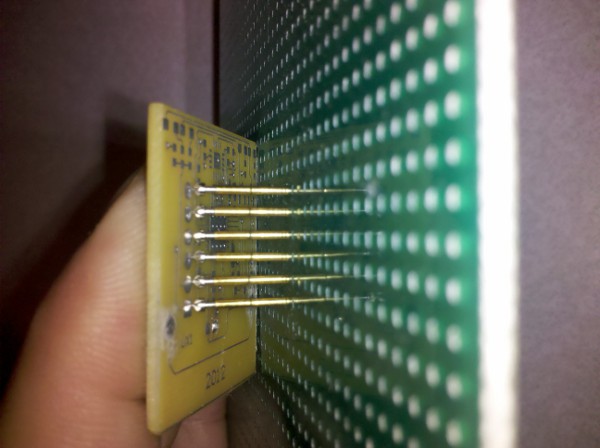Stupid Boxes
Posted by FirmWarez on 7 Oct 2012 in Blog | 0 comments

Most of my electronics work, both career and hobby oriented, involves “smart boxes” — embedded systems that measure, analyze, communicate, control, and react. Sometimes when working on projects, “smart” isn’t what you need.
I’ve made a bunch of “stupid boxes” for lab and and other electronic/electrical work. “Stupid” because they don’t have microcontrollers doing amazing things, or even much in the way of active components. But they sure are helpful. Maybe you’ll find them helpful in your lab or shop too.

1) Momentary switch with long wires
This is primarily a garage thing. Great for bumping over starter motors or testing components where the action is far away from the part. Just a pushbutton switch in a plastic enclosure with long wires terminating in large alligator clips. Built to handle being tossed around in the garage and the current draw of a starter solenoid. Pretty stupid, but helpful.

2) Arm box with pushbutton:
Power in to a safety cover protected toggle switch and a momentary pushbutton. Toggle switch to arm, pushbutton to fire. Great for model rockets or setting off thermite in your backyard. Intended for +12V applications. The input side is power of course, the output side has both the “arm” output from the toggle, and the momentary pushbutton output. That way the cover protected toggle can be used to power something that you might want to shut down in a hurry, like a fuel pump. If you need to shut it off, just smack the safety cover.
3) Momentary DPDT center off polarity reverser
Just a switch in a box, with power in terminals and power out terminals. The momentary DPDT is normally off, push one way and you get one polarity out, reverse the switch direction for reverse polarity. Ever had project with a DC motor that you need to take over control for a minute? Or wanted to test DC motors both directions without connecting leads back and forth? This box makes it easy. Stupid, but good. Also helpful if you are disassembling a parts Range Rover and remove the wiring harness and then realize you want to move the electric seats around.
4) Relay test box
As you can tell, I’m a bit of a gearhead. Modern cars are covered in relays. I’ve got boxes full of ’em. Bad relays cause all sorts of problems from apparent fuel pump failure to flakey pop-up headlamps on a Triumph TR8. I built this little box to test relays. +12V in, a pushbutton to fire the relays, and LEDs to indicate power in, and the NO and NC functions of the relay. That’s “normally open” (off) and “normally closed” (on). Admittedly there can be failure modes where this box would show a relay good, but the relay may not handle the current of an actual application. But then usually in those situations the relay has burned contacts, which may show up on this box as an intermittent or dim LED.
5) LED test box
Who doesn’t love LEDs? And who doesn’t buy (or get given) bags of surplus LEDs? I got tired of alligator clipping things together and built a stupid box with a rotary switch with various common LED current limiting resistors, as well as taps for measuring the LED Vf. Yeah, back when I did my undergrad we were told “LED’s have a forward voltage drop of 1.7V”. That’s because LEDs were red, and dim back then. Times have changed! With this box you plug in your power supply through an ammeter, plug a voltmeter in to the appropriate connections, clip on your LEDUT (LED under test) and rotate the switch checking Vf and how the LED responds to differing currents. “Caution! This machine has no brain, use your own!” Yeah, this is a stupid box; if you do something stupid you could burn up your LED. Start with higher resistor values first (that is less current) and work your way down. Keep in mind that your typical LED (I’m not talking high brightness special LEDs) are rated around 20mA to 25mA. Exceed the maximum current rating, and it will fry. There’s a good guide to newbie LED stuff titled “Basics: Picking Resistors for LEDs” at the Evil Mad Scientist Laboratories.
6) Ruggedized +12V power supply
When I’m in the lab having a good +12V supply is no big deal. But it seems I always need some +12V in the machine shop or the garage to power or test something. This stupid box is a nice little 1.6A +12V supply in a rugged metal box, with a standard AC input, a power switch, and binding post outputs. Sure, I could have bought something like this, but I had a bunch of these nice, reliable, sealed little +12V supplies, so I put one in a rugged metal enclosure for garage work.
7) Stupid “other stuff”
They aren’t boxes, but still fall in to same category as the others — simple little things to make life easier in the lab. I’ve got a board with pogo pins for in-circuit programming of Microchip PICs. Originally done for a tiny board that didn’t have room for a through-hole header, it’s also handy for programming limited quantity “production runs” when you don’t want to have headers soldered in place. Line up the pogo pins with the ICD pads on the board, push the board against the spring loaded pins, and program. If you are going to be doing the same exact board over and over add some mechanical alignment blocks and anypony can program the boards for you. Adafruit sells pogo pins in low quantity; they can be hard to find in hobbyist volume from other sources. Other “stupid stuff” includes various switches on leads soldered to 0.1″ sockets. Pushbuttons, SPDT, all those little input things you need in a format handy to use with prototypes and development boards.

I’ve found these things to be major time savers. Build them right and they are more reliable than alligator clipping things together over and over, and much easier to use. Yes, there are other ways to do all of this, but if you are continually doing the same tasks (like the LED tester) it helps to have an easy to use solution on hand. Have made a “stupid box” that is timesaver in your lab? Let me know!
